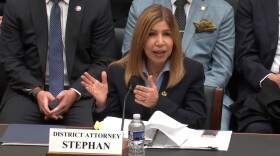A controversial artwork, called "Three Slick Pigs," remains part of the Street Legacy: SoCal Style Masters exhibition at the California Center for the Arts, Escondido. The mixed-media piece presents a graffiti-marked black and white photograph of police in riot gear with a fiberglass sculpture of three dancing pig figures in the front.
Negative reactions to the piece from Escondido officials prompted the art center to convene a special meeting to discuss the possible removal of the art. But in the end, the trustees reaffirmed their commitment to the exhibition and all the works in it.
Dr. James Daichendt is an art historian at Point Loma Nazarene University and co-curator of the SoCal Style Masters exhibition, along with Bobby Ruiz. Daichendt spoke with KPBS Midday Edition host Maureen Cavanaugh.
This exhibit features street art. It's one of your specialties. Is it difficult to translate the meaning and impact of street artistry in a white-walled art space?
Daichendt: Absolutely. It's definitely difficult. Once you move something from street culture into the clean, white walls of a gallery, it gets interpreted differently, and you get a different audience, and they take their time and attention to the artwork in a different way.
The "Three Slick Pigs" artwork is described as, "a satirical look at excessive police force and abuse of power with imagery from the 'Three Little Pigs' fairy tale." But it's not exactly a breakthrough concept to compare police officers to pigs. That's been happening for 60 years. So what's especially compelling about this piece?
Daichendt: Yeah, so what's compelling about the exhibit altogether and the piece in general, is that we've invited a number of artists from subcultures within what we call street culture, which includes graffiti, street art, tattoo, lowriders, surf, skate culture. And these are perspectives that we often don't see in the museum or the gallery setting. And so the imagery can be shocking. It can be off-putting or just unusual because it's just things that we normally don't see in our everyday life. So when you have an exhibit that's as diverse as this one, you're bound to see some visual imagery that provokes — and maybe even shock. But my hope is that it's stuff that we can learn from, and that we can ask ourselves why we're reacting in the way that we are.
The creator of this piece goes by the name OG Slick. Do you think he was trying to get the kind of reaction the artwork did get from Escondido officials?
Daichendt: I don't believe Slick was trying to provoke Escondido, and I think this is where we personalize artwork. The artwork has nothing to do with the fine folks who work in Escondido or any particular police department or officials or authority figures. It is satirical. It's in the abstract. To think that there hasn't been abuse of power by folks who are — that are presumed to be authorities, that would be an error in our thinking, because we see that on the news all the time. So we're looking at someone who has presented an alternative viewpoint of their interactions with police force.

The California Center for the Arts, Escondido is funded by the city of Escondido. Some city officials, including the mayor, were quite unhappy with the "Three Slick Pigs" piece. Are you concerned about this controversy possibly causing the center to lose funding? (Correction: The Center receives partial funding from the city of Escondido.)
Daichendt: I'm not concerned about it. I think if given time and conversation, we all get a better understanding of the visual arts. And my hope is that the mayor or anyone that had a negative reaction would be willing to talk about it in depth with someone who is coming from another perspective.
Well, you say the reaction to this artwork falls into a dangerous area of censorship. Can you tell us about that?
Daichendt: If every time we see an image and artwork, whatever it may be — a film, some music that we're listening to that doesn't correspond with our own personal beliefs — and we want to censor it, that's a really dangerous road to be going down.
The "Street Legacy" exhibit features work from 100 artists. Tell us about some of the other major works included.
Daichendt: We have so many fascinating artworks that are part of this exhibit and by some of the biggest names in graffiti, street art, tattoo, lowriders that are working today. And some may be household names, like Shepard Fairey, who came to light from the Obama "Hope" poster that he made during that election, to some smaller artists that are lowrider painters that are pushing that field forward. In fact, we have car paint that lights up because it has this current that actually runs through the automotive paint. So there's some really fascinating aspects that are pushing street culture forward in so many different ways. And I think 99% of the visitors that are coming in are absolutely thrilled and are taking pictures with the various artworks because it is fun. I like to describe the artwork on display as it meets us where we are, because this is the kind of artwork that we see in our daily lives. It's usually not behind the doors of the museum. These are things that we see when folks are cruising on Friday nights or the type of artwork that may be up in an alley on your walk. So it's really practical, it's useful, it's fun, and I hope folks will enjoy it.
And what about the role police play in street art and graffiti?
Daichendt: There's a number of studies, if we go back a few decades, that most of the sociological studies and psychological studies, when we talk about street art and graffiti, it's about control, it's how to control it, how to curb it. And it wasn't until the last 10, 15 years that we see more studies on graffiti, trying to understand it, maybe celebrate it in different ways. And graffiti inherently, when it's just writing on a wall, it is illegal. It goes back to ancient civilizations, that people have been writing graffiti on things, but it has transformed in the last few decades into a legal art form as well. As we see, street art and murals play a really important part in our communities, and you often see them on the sides of apartment buildings or significant architecture. So there's been a development from it being something that's merely writing on walls and destruction of property to something that's been important for economic growth and for identity in our communities.
What do you think this exhibit, the controversy and its resolution does to the Center for the Arts, Escondido's reputation among artists and art supporters?
Daichendt: The Center's reputation has only gone up in the world of art folks, art appreciators, and anyone who engages in the arts in a serious way. So the reaction afterwards was celebration. And even if artists weren't — or supporters weren't admirers of the piece that was under question, the right for folks to be able to talk or exhibit about such things was important. So I'm excited for the Center. I'm excited for folks that patronize it, but I'm also excited about the future conversations that will happen with anyone that was upset about it. And I know that I'll be front and center for a lot of those conversations, because that's a big part of what I do as a professor. It's about looking closer and getting a better understanding of visual things and how we interact with them in the world.
'Street Legacy: Socal Style Masters'
- Add to Google Calendar
- Add to Outlook Calendar
Download ICS file








